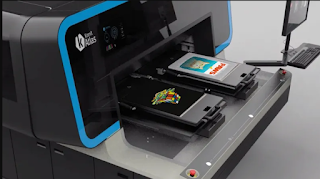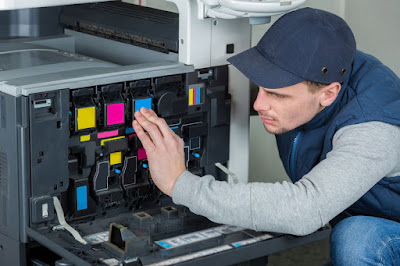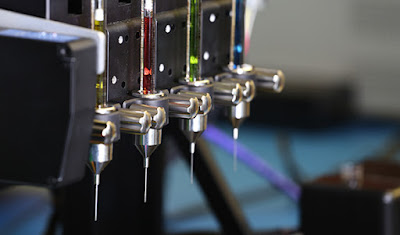Notwithstanding my work in the business printing field, I do craftsmanship treatment work with my fiancee. We show medically introverted understudies to make craftsmanship. We do everything from attracting to painting to model to custom printing.
In past issues of the PIE Blog I have expounded on some of the procedures of custom printing that we have brought to our understudies, and in the most recent week I have been concentrating one that we have not yet utilized: collography. I'd like to quickly depict this system alongside another I simply found in looking into Andy Warhol for an ongoing painting class. His system was designated "the smudging line," and this alongside his following work formed into the Pop Art custom screen printing for which he was well known. At last, I need to depict "monotyping," a third system I intend to impart to my fiancee's and my mentally unbalanced understudies.
What makes these fascinating to me is that all should be possible with basic materials and no business printing press. These printing plates can be inked and printed by hand. This means anybody with the intrigue can do any of these methods with a decent measure of achievement. Besides, nothing causes you to comprehend the aestheticness in current, computerized, business printing like an individual involvement with one of the hand-printing systems. All things considered, custom printing is both a workmanship and an art.
Collagraphy
"Collagraphy" (likewise spelled "collography") is gotten from the Greek words for "paste" and "composing." The procedure was created in 1955 by Glen Alps. Collagraphy begins with a printing plate made of wood or paperboard (bristol or maybe chipboard, for example). You add materials to develop surface (as well as topic). At that point you paint ink or move ink onto the raised regions of the plate (to create a "consolation" or raised print), or you utilize a roller or paint brush to flood the plate with printing ink, and after that you clear the ink off the raised territories. (This yields an "intaglio" print in which the recessed territories of the plate move the ink to the paper substrate.)
What makes this fascinating is every one of the materials you can utilize. Notwithstanding sticking down bits of cardboard, you can develop surface with gesso or other acrylic media, or you can paste leaves or even banana strips, materials, string, or sandpaper to the plate. Along these lines you can make examples or surfaces.
Generally speaking, this procedure will enable you to make emotional tonal varieties because of the profundity (i.e., thickness) of the help plate and the surfaces you can make.
(Looking at the situation objectively, this isn't unique in relation to the raised territories that are developed for wrinkling and scoring paper utilizing the Highcon Euclud computerized machine. With this gear, you can utilize advanced information to deliver raised regions on a plate that will at that point wrinkle and score press sheets.)
One thing I have found out about collagraphy in some workmanship books is that once you make the plate, you can shellac it. This will seal the plate and give an impermeable surface that you can all the more effectively wipe perfect as you change or include ink hues.
When you have made the plate, you can print it. Since a large portion of you (myself included, really) won't approach a workmanship printing press, you can simply lay the printing paper over the inked plate and after that shine it with the back of a wooden spoon. When you strip off the printing paper, the picture will move from the collagraph plate to your printing sheet.
(To allude back to the workmanship treatment work my fiancee and I do, we once made innate covers utilizing the fluting of layered board for surface. Our understudies stuck bits of this fluting to level folded liner board, making help figures of the covers. In spite of the fact that we didn't have the opportunity to do any printing, we could without much of a stretch have utilized these alleviation veil designs as collagraph plates and printed the covers onto press sheets. Truth be told I would like to do this equivalent undertaking again at some point and have the understudies make the veils as well as use them as custom printing plates too.)
Andy Warhol's Blotting Techniques
I read Andy Warhol's work for an ongoing workmanship class with our mentally unbalanced understudies so I could give foundation data as the understudies drew and afterward painted shoes. Right off the bat in his profession, Andy Warhol, who was really conceived Andy Warhola, did representations for Glamor magazine. In the event that you find him on the web, you will discover a considerable lot of his drawings of high-design shoes. My fiancee and I utilized these shoe representations as a beginning stage during the current week's craft treatment painting venture.
While Warhol was drawing and painting shoes, he thought of a strategy called the "smudging line" system which included attracting a line ink and after that blotching it while it was as yet wet. This changed the surface of the line and was in an extremely essential manner a printing strategy (moving a picture starting with one level surface then onto the next by blotching). As straightforward as this sounds, it formed after some time into not exclusively Warhol's mark style of promoting craftsmanship yet additionally the photograph silkscreen printing for which he is so outstanding. In the two cases (and in his utilization of photocopy machines and following), Warhol investigated the creative impacts of rehashed pictures. (You may have seen Warhol's various pictures of Campbell's Soup Cans or numerous pictures of Marilyn Monroe's famous face.) All of this, in addition to the underlying "printing" nature of the "smudging line" procedure, was fused into Warhol's masterful style.
Monotype Printing
Here's another method you can do at home without a business printing press. It's called monotyping, and you can do it in various manners. You can paint a picture onto a non-permeable plate, (for example, a plexiglass, glass, or—as was done verifiably—copper plate). At that point you place the printing paper over the inked plate, and you polish it with even weight the whole way across the back of the sheet utilizing the back of a wooden spoon to press the paper into the ink. You can do this with a printing press also, yet for this situation, you can't utilize a glass plate, or it will break from the weight.
Another approach to make a monotype (for this situation called an exchange monotype) is to initially ink the plate totally in a solitary shading. At that point you lay the printing sheet over the ink and cautiously draw a picture on the back of the sheet with a pencil or stylus. (On the off chance that your fingers contact the paper, even slight weight will move ink from the plate to the printing paper.) When you strip the press sheet off the plate, the regions you have attracted will be shading (the weight of the pencil grabs ink from the printing plate), and everything else will be the unprinted paper.
A third method to approach monotypes is to ink the plate totally and afterward use paintbrushes, clothes, and additionally a stylus to expel ink specifically from the strong foundation before printing.
Monotyping yields one great print. Notwithstanding, the exchange from the plate to the substrate changes the idea of the lines and solids in unobtrusive manners (the weight does this to the ink film). Along these lines, you end up with a solitary, to some degree uncontrolled however all things considered extraordinary picture. On the off chance that you attempt to print the plate once more, you will typically get just a black out picture.
(In the event that you do some examination, you'll see that the British Romantic artist William Blake made monotypes to represent his verse.)
Picking the ink is a significant advance. I have found out about printing with watercolors, yet I have had more accomplishment with real oil-based printing inks. On the off chance that you pick oil-based inks you can print the substrate either wet or dry. In the event that the printing stock is dry, there will be more difference in the print. On the off chance that the paper is wet, you'll get a more prominent scope of tones.
When you have printed the plate, you can return into the picture with watercolor, ink, or some other medium to adorn the work.
What you escape this is the fortunate mishaps likened to watercolor painting. Since you can't control each component of monotyping, you join the components of shot and anomaly into your work, and this frequently makes the craftsmanship print increasingly special.
How Does This Pertain to Commercial Printing?
Despite the fact that a few specialists believe expressive arts to be better than business craftsmanship, in the event that you do the examination you'll see that such celebrated craftsmen as Toulouse Lautrec (publications), Piet (Mondrain format lattices for visual depiction), Andy Warhol (screen printing and delineation), and N.C. Wyeth (magazine delineations) all worked in both the expressive arts and realistic (or business) expressions. All things considered, the standards of good plan traverse from one control to the next.
On the off chance that you are a visual fashioner or a printer, it can just improve your energy about your specialty to perceive how popular craftsmen have moved toward custom printing. Understanding the historical backdrop of human expressions widens and extends your very own insight and aptitude in your art.
As noted previously, figuring out how to imprint pictures will enable you to comprehend the workmanship and specialty that underlie the mechanization of contemporary business printing. You will comprehend, for example, what it implies for pictures to be "in register." This idea becomes possibly the most important factor whether you're utilizing a million dollar press or printing hues from a glass printing plate, utilizing a wooden spoon to rub the picture from the plate onto the paper.
So the short answer is that nothing engages us like information and individual experience. In addition, learning and experience can upgrade our affection for our specialty.
Read more







